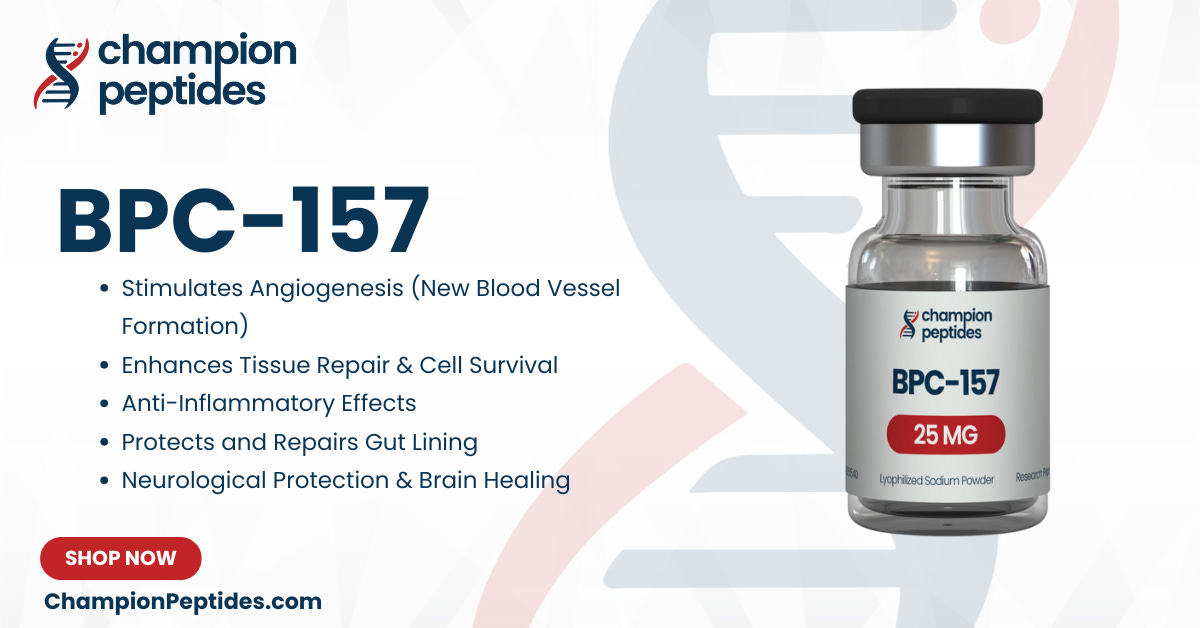Body Protection Compound-157 (BPC-157) represents a significant focus in peptide research, particularly within academic institutions studying tissue repair mechanisms and cellular regeneration pathways. This synthetic pentadecapeptide, derived from a protective protein found in gastric juice, has become an essential tool for researchers investigating wound healing processes and vascular biology at the molecular level.
PART 1: ACCESSIBLE OVERVIEW
What is BPC-157?
BPC-157 is a synthetic peptide consisting of 15 amino acids that researchers have isolated and modified from a naturally occurring protective protein. Scientists at institutions worldwide are studying this compound to understand how certain peptide sequences might influence cellular repair mechanisms in laboratory settings.
The peptide has gained attention in research communities because of its unique molecular structure and its interaction with various cellular pathways involved in tissue maintenance. Research laboratories use BPC-157 to investigate how peptides can influence angiogenesis (blood vessel formation), collagen synthesis, and cellular migration patterns in controlled experimental conditions.
Current Research Focus Areas
Research institutions are primarily investigating BPC-157’s effects on:
Angiogenesis Research: Scientists study how this peptide influences the formation of new blood vessels in laboratory models, particularly examining its interaction with vascular endothelial growth factor (VEGF) pathways.
Tissue Repair Mechanisms: Laboratories analyze the peptide’s influence on fibroblast activity and collagen production in cell culture systems, providing insights into fundamental wound healing processes.
Gastrointestinal Research: Given its origin from gastric protective proteins, researchers examine BPC-157’s effects on gastric mucosa and intestinal barrier function in experimental models.
Vascular Biology: Research teams investigate the peptide’s interaction with endothelial cells and its potential influence on blood flow patterns in laboratory vascular models.
Clinical Research Landscape
While BPC-157 remains in early-stage research, several academic institutions have initiated preliminary studies examining its biochemical properties. These investigations focus on understanding the peptide’s molecular mechanisms rather than therapeutic applications, maintaining strict research-only protocols.
Research conducted at Croatian institutions has provided foundational data on BPC-157’s molecular interactions, while laboratories in the United States and Europe continue expanding this research through controlled experimental studies.
PART 2: SCIENTIFIC LITERATURE REVIEW
Molecular Mechanisms and Biochemical Pathways
BPC-157’s research applications center on its complex molecular mechanisms, particularly its interaction with several key signaling pathways involved in cellular repair and vascular function.
VEGF Pathway Modulation: Research indicates that BPC-157 influences vascular endothelial growth factor expression in cell culture systems. Studies using quantitative PCR analysis have demonstrated upregulation of VEGF mRNA in endothelial cell lines treated with BPC-157, suggesting the peptide’s role in angiogenic signaling cascades.
Nitric Oxide Synthase Activation: Laboratory investigations have revealed BPC-157’s ability to modulate nitric oxide synthase (NOS) activity in experimental models. Spectrophotometric analysis of NOS activity shows increased enzyme function following BPC-157 treatment, correlating with enhanced nitric oxide production in vascular tissue samples.
Growth Factor Receptor Interactions: Research utilizing protein binding assays demonstrates BPC-157’s interaction with various growth factor receptors, including EGFR (epidermal growth factor receptor) and PDGFR (platelet-derived growth factor receptor). These interactions appear to activate downstream signaling cascades involved in cellular proliferation and migration.
Advanced Laboratory Protocols and Analytical Methods
Cell Culture Applications: Research laboratories employ BPC-157 in primary cell culture systems, particularly with human umbilical vein endothelial cells (HUVECs) and dermal fibroblasts. Standard protocols involve peptide concentrations ranging from 1-100 μg/mL in serum-free media, with analysis conducted through MTT proliferation assays and wound scratch tests.
Molecular Biology Techniques: Researchers utilize RT-qPCR analysis to examine BPC-157’s influence on gene expression profiles, particularly focusing on collagen synthesis genes (COL1A1, COL3A1) and angiogenic factors (VEGFA, ANGPT1). Western blot analysis protocols examine protein expression changes in treated cell cultures, with particular attention to p-Akt and p-ERK signaling pathway activation.
Analytical Chemistry Requirements: High-performance liquid chromatography (HPLC) remains the standard for BPC-157 purity analysis in research applications. Mass spectrometry protocols verify peptide identity and structural integrity, while amino acid analysis confirms sequence accuracy. Research-grade BPC-157 requires >98% purity as determined by analytical HPLC.
Storage and Handling Specifications for Laboratory Use
Research laboratories must maintain BPC-157 under specific conditions to ensure experimental reliability:
Storage Requirements: Lyophilized peptide storage at -20°C with desiccant protection maintains stability for extended periods. Reconstituted solutions require storage at 4°C and use within 30 days for optimal research results.
Reconstitution Protocols: Research applications typically employ bacteriostatic water or sterile PBS for peptide reconstitution. Standard concentrations for cell culture work range from 1-10 mg/mL stock solutions, with further dilution in experimental media.
Quality Control Measures: Each research batch requires analytical verification through HPLC analysis and mass spectrometry confirmation. Endotoxin testing ensures suitability for cell culture applications, with levels below 0.1 EU/mL required for most research protocols.
Current Clinical Research Data
While comprehensive clinical data remains limited due to BPC-157’s early research stage, preliminary studies have provided valuable insights into its biochemical properties:
Pharmacokinetic Studies: Limited research suggests rapid absorption and distribution in experimental models, with peptide detection in plasma samples within 30 minutes of administration in laboratory studies.
Dose-Response Relationships: Laboratory investigations have established concentration-dependent effects in cell culture systems, with optimal responses typically observed at 10-50 μg/mL concentrations in most experimental protocols.
Stability Analysis: Research demonstrates BPC-157’s relative stability under physiological conditions, with peptide integrity maintained for several hours in biological media at 37°C.
Research Applications in Academic Institutions
Universities and research institutions worldwide incorporate BPC-157 into various research programs:
Regenerative Medicine Research: Laboratories studying tissue engineering applications examine BPC-157’s influence on cellular scaffold integration and tissue formation in laboratory models.
Vascular Biology Studies: Research teams investigate the peptide’s effects on endothelial function and vascular remodeling processes using advanced imaging techniques and molecular analysis.
Wound Healing Mechanisms: Academic laboratories employ BPC-157 in controlled studies examining cellular migration, proliferation, and extracellular matrix formation in experimental wound models.
For research institutions seeking high-purity BPC-157 for laboratory applications, Champion Peptides, (https://championpeptides.com) provides analytical-grade compounds meeting strict research specifications. Our BPC-157 10mg(https://championpeptides.com/product/bpc-157-10mg/) and BPC-157 25mg (https://championpeptides.com/product/bpc-157-25mg-2/) formulations undergo comprehensive analytical verification to ensure research reliability.

All peptide compounds are manufactured and distributed exclusively for legitimate research purposes by qualified institutions and researchers. Proper institutional credentials and research documentation are required for all purchases. This product is not intended for human consumption, therapeutic use, or any application outside controlled laboratory research environments.

